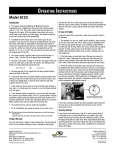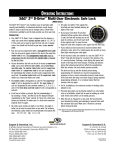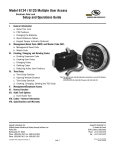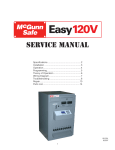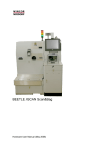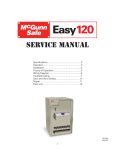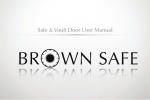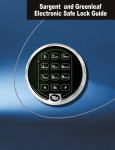Download Sargent and Greenleaf 6123 Operating instructions
Transcript
Operating Instructions Model 6123 Introduction In Case of Trouble • The Sargent & Greenleaf Model 6123 Motorized Electronic Combination Lock is shipped from the factory with a factory master code of 1 2 3 4 5 6 #. This code is used to open the lock and set or change all of its codes. If the safe maker or your dealer sets a new master code, he will advise you of the change. You should set the lock to your own, unique master code immediately. If your lock should fail to open when a valid code is entered, check for the following: • The Model 6123 will always open on the master code. At your discretion, it can also be set to accept a supervisor code, up to five different user codes, and a time delay override code. The master code holder is responsible for maintaining the number of active users programmed into each lock. • Each time a button is pressed and the lock accepts the input, it emits a “chirp,” and the LED on the keypad lights momentarily. • All codes must contain six digits or six letters. Any digit or letter can be used as many times as you wish. For instance, the following codes (while not recommended) will operate the lock: 555555# OR JJJJJJ# • All codes end with #. This signals the lock that you have finished entering all digits of the code. • If you pause more than 10 seconds between pressing buttons when entering a code, the lock will assume you do not want to continue, and it will go into standby mode. To open the lock, begin the code entry sequence from the first step. 1. The boltwork of a safe can, under certain conditions, place pressure on the side of the lock’s bolt. This is often caused by something inside the safe pressing against the door or by something caught between the safe door and its frame. When this occurs, the lock will not operate properly. To relieve side pressure on the lock bolt, move the safe’s handle to the fully locked position, then re-enter a working code. The lock should open. 2. If the lock makes no sound when any of the keys are pressed, or if the lock “chirps” when keys are pressed, but it will not open, the batteries may be drained to the point that they will not operate the lock’s motor. Follow the battery replacement procedure in this manual. 3. If the lock makes no sound when any of the keys are pressed, but the batteries have been checked and found to be good, a loose keypad connector may be the cause. If your lock uses the two-battery keypad (pictured to the left of the lock above), pull the keypad away from the base as described in the battery changing procedure. Check to make sure the wire connector is firmly seated into its receptacle on the keypad circuit board. The connector is designed so that it will only slide into the receptacle when aligned correctly. • If you realize you have pressed an incorrect button when entering a code, press * or simply pause ten seconds or more, then begin entering your code again. Wire connector being inserted into the receptacle on the keypad circuit board. • If four incorrect codes are entered in a row, the lock will shut down for a period of up to fifteen minutes. This is a security feature. Pressing any button anytime during the lockout period will reset the timer to its maximum penalty time. Do not touch any keypad buttons for a period of fifteen minutes, then enter any valid code to open the lock. If all of the preceding remedies have been exhausted and the lock still does not open, contact a qualified safe technician in your area for professional service. • The model 6123 does not have audit trail capabilities. Security Advisory • For UL installations, the maximum number of user codes is one. If your lock is used many times a day (50 or more openings daily), it is advisable to use as many different keys as possible in your code number. Avoid using a key more than once whenever possible. Check the keypad frequently for visible wear which might indicate which keys are being pressed for code entry. Change the code to use different keys when wear is evident. If necessary, have a qualified service technician replace the keypad. Note: This lock has been Listed by Underwriters Laboratories for use with the following S&G keypad(s): 6120-0XX, 6120-2XX, 6120-4XX, 6160-2XX (IP Series), 61KP-1XX, 6130-5XX To Open the Lock Press the code digits or letters in order, followed by #. The lock bolt will retract for six seconds, allowing you time to turn the safe handle and open the door. Do not put any pressure on the handle until after the code has been entered. The Model 6123 will lock automatically when the safe door is closed and the handle is turned to the locked position. Sargent & Greenleaf, Inc. A Wholly Owned Subsidiary of Stanley Security Solutions, Inc. PO Box 930 Nicholasville, KY 40340-0930 Phone: (800)-826-7652 Fax: (800)-634-4843 Phone: (859)-885-9411 Fax: (859)-887-2057 © Copyright 2007, Sargent & Greenleaf Sargent & Greenleaf S.A. 9, Chemin du Croset 1024 Ecublens, Switzerland Phone: +41-21 694 34 00 Fax: +41-21 694 34 09 Document 630-327 Revised 7/23/2010 Decisions—MRC and TDO MRC—Management Reset Code Before any buttons are pressed, you need to make some decisions. The first is whether or not your lock is to have a management reset code, also known as the MRC. This code must be programmed into the lock before the master code is changed for the first time. After the master code is changed, the lock can never be programmed with an MRC. Conversely, when an MRC is programmed into a lock, it is always present. It cannot be deleted or changed. Some 6123 locks have factory installed management reset codes, depending on how they were ordered by the safe maker or dealer. You cannot install a new MRC to replace an existing one. The management reset code is used to regain control of a lock when its master code is lost. When the MRC is employed, it deletes the supervisor and all user codes present in the lock and changes the master code to the factory default of 1 2 3 4 5 6 #. While this can be a real time and money saving feature if a master code is lost, the presence of a management reset code in a lock could also be viewed as a security weakness under some circumstances. Carefully consider whether or not you want to program an MRC into you lock. If you decide to use this feature, here’s what you need to know. Important: All programming and code changing should be done with the safe door open. Do not close the safe door until all programming and/or code changes are completed and triple checked to make sure everything is working correctly. . . . . An MRC consists of seven digits, including one 01 or 03 pair that can appear once anywhere in the code, grouped between two periods. When entering the MRC, these two digits are pressed simultaneously. An example of an acceptable management reset code is: 7481 03 5 . . Before programming the MRC into the lock, enter the master code (123456#) to make sure the lock is functioning correctly on the factory default master code. When the bolt extends: Press * * # 123456# (_______) # management reset code (_______) # management reset code . . . . Remember that the 01 or 03 pair of digits in your management reset code must be pressed at the same time. The lock will emit three rapid beeps after the final # is pressed to acknowledge the successful programming of the MRC. If you don’t hear those three beeps, the MRC has not been programmed. If you hear a long tone (called a “brap”) while trying to program the MRC, either you’ve made an error in the entry sequence, the lock already has an MRC, or the master code has already been changed. Even if the master code is changed, then set back to 1 2 3 4 5 6 #, the management reset code cannot be set. The procedure for using the management reset code to reset a lock with a lost master code is found later in the manual. TDO—Time Delay Override Note: Time delay override is not available if the lock is used in supervisor/user mode. If your 6123 will be using a time delay, you may also want to program a time delay override capability. Like the MRC, you’ve got to make this decision and do the programming before the master code is changed for the first time. A time delay is used to deter armed robbery. Statistics show that the longer an armed robber has to wait for a safe to open, the less likely he is to initiate the crime. The 6123‘s time delay feature enforces a waiting time between the entry of the lock code and the opening of the safe. Often a safe that requires a time delay lock is involved in a cash carrier or armored car pickup process. Excess cash receipts are picked up at various intervals by armored car services. In the interest of security and efficiency, it is important that these couriers do not spend any more time than is absolutely necessary to access the safe, remove the excess valuables, and be on their way. This is where the time delay override code comes into play. It allows one code to override the lock’s time delay and open the safe immediately. Before the lock’s master code is changed for the first time, you should determine whether or not you will need a time delay override code or not. If you will need a TDO, you must decide if it will be a single user time delay override or a dual control time delay override. If you do not want your 6123 to have time delay override capability, use the following programming sequence to permanently remove it: 8 3 * 1 2 3 4 5 6 # 1 # 1 # The lock will emit three rapid beeps after the final # is pressed to acknowledge that the time delay override capability has been irrevocably removed. If you don’t hear those three beeps, or if you hear a long tone (called a “brap”) while following this procedure, either you’ve made an error in the entry sequence, or the master code has already been changed. A single user time delay override code allows the holder of the code to enter it into the lock and immediately gain access to the safe. He does not have to wait for the time delay, and there are no other actions required. To program the lock for single user time delay override, use the following procedure: 4 6 * 1 2 3 4 5 6 # 2 # 2 # The lock will emit three rapid beeps after the final # is pressed to acknowledge that the single user time delay override capability has been set. If you don’t hear those three beeps, or if you hear a long tone (called a “brap”) while following this procedure, either you’ve made an error in the entry sequence, or the master code has already been changed. A dual control time delay override is somewhat similar, with one restriction placed on it. The override code will only open the safe when it is entered Page 2 within one minute of another code holder entering his or her code to start the time delay. For example, when the armored car shows up at the safe, a store employee would enter the master code, the supervisor code, or any user code to start the lock’s time delay. Within one minute, the armored car person would enter his code. The safe would immediately open, rather than enforcing the entire time delay period. The dual control time delay override is often preferred, because it imposes a supervisory restriction on the only person who has a code that will circumvent the time delay. To set the lock for dual control time delay capability, press: 4 6 * 1 2 3 4 5 6 # 1 # 1 # The lock will emit three rapid beeps after the final # is pressed to acknowledge that the dual control time delay override capability has been set. If you don’t hear those three beeps, or if you hear a long tone (called a “brap”) while following this procedure, either you’ve made an error in the entry sequence, or the master code has already been changed. Once you’ve successfully set a management reset code (if desired) and a time delay override method (or deleted the capability permanently), you can perform any of the lock’s other programming functions, including changing the master code. Any programming you do from this point on can be changed. Either type of time delay override still requires you to select and set the actual six-digit TDO code number that will be used to open the safe. Even if the capability for TDO has been programmed, it is useless until a code is programmed. The code can be set, changed, or deleted at any time by the holder of the lock’s master code. It is easiest to set the time delay override code before a time delay period is programmed. To do so, press: Press SG* (______) # 9 * (______) # (7 4) existing master code new TDO code (______) # new TDO code If a time delay period is already programmed into the lock, the time delay override code can only be set, changed, or deleted during the opening window, which is explained later in the manual. Access Methods—modes of operation Single User Mode One person with a single, valid, six-digit code can open the lock. Lock features can include time delay and time delay override code, if desired. The holder of the master code can perform all programming functions. The holder of the supervisor code (if it’s set) can set, change, and delete user codes. He can also change and delete his own code. User code holders can change their own codes. Your lock left S&G’s factory in single user mode (the default mode). If it’s in another mode and you want to change it to single user mode, follow this programming sequence: 3 2 * (______) # 0 # existing master code 0 # Dual Control Mode This is also referred to as dual user mode. It requires two different valid lock codes to be entered within one minute of each other for the lock to open. The idea is that no one person has the ability to open the safe alone. Lock features can include time delay and time delay override code, if desired. The holder of the master code can perform all programming functions. The holder of the supervisor code cannot perform any programming or code changes. He cannot even change or delete his own code. User code holders can change their own codes. You should also be aware that a single user time delay override code can open the lock immediately without entry of a second code. The dual control time delay override will require another code to start the time delay before it can be used to open the safe. A time delay period of at least one minute must be programmed into the lock for a time delay override code of either variety to work. It cannot open a lock that is not using the time delay feature. If your lock is in another mode and you want to change it to dual control mode, follow this programming sequence: 3 2 * (______) # 1 # existing master code 1 # Supervisor/User Mode This is sometimes referred to as supervisor/subordinate mode. In this mode, the master code and the supervisor code cannot open the lock. Instead, they are used to enable and disable the lock for opening by the user codes. When either the master code or the supervisor code (if set) is entered, the lock will emit four short beeps or two long beeps. If it gives the four short beeps, any user code can subsequently be used to open the lock. The next time the master code or supervisor code is entered, the lock will emit the two long beeps. Now the user codes cannot open the lock. When the lock is disabled and a user code is entered, it does not open, but emits two long beeps instead. The master code and supervisor code are effectively used to toggle the lock back and forth between usable and non-usable states. Lock features can include time delay, but the time delay override is not available in this mode. The holder of the master code can perform all programming functions. The holder of the supervisor code (if it’s set) can set, change, and delete user codes. He can also change and delete his own code. User code holders can change their own codes and open the lock when it is enabled by the master code or supervisor code. To place your 6123 lock in supervisor/user mode, press: 3 2 * (______) # 2 # existing master code 2 # Page 3 Setting / Changing / Deleting Codes The Master Code As mentioned previously, the master code can perform all programming functions for the 6123 lock. The master code can be changed, but the lock will not allow you to delete it. The factory default master code is 1 2 3 4 5 6 #. We strongly suggest you change it to a six-digit code of your own choosing before storing anything of value in your safe. Only the holder of the master code can change the master code. The sequence is: Press SG* (______) # 1 * (______) # (7 4) existing master code new master code (______) # new master code If the long error tone (brap) sounds at any time during the master code changing procedure, you have made an error. The old master code is retained. The Supervisor Code The supervisor code can change and delete itself (once set). It can be set, changed, and deleted by the holder of the master code. The process for using the master code to set or change the supervisor code is: Press SG* (______) # 2 * (______) # (7 4) master code new supervisor code (______) # new supervisor code If the long error tone (brap) sounds at any time during the supervisor code changing procedure, you have made an error. The old supervisor code is retained. To delete the supervisor code, the master code holder enters: Press SG* (______) # 2 * # # master code If the long error tone (brap) sounds at any time during the supervisor code deletion procedure, you have made an error. The old supervisor code is retained. Here is the sequence the supervisor code holder uses to change his own six-digit code: Press SG* (______) # 2 * (______) # (7 4) old supervisor code new supervisor code (______) # new supervisor code If the long error tone (brap) sounds at any time during the supervisor code changing procedure, you have made an error. The old supervisor code is retained. The supervisor code holder can delete his code completely from the lock, except when it is in dual control mode. This is the procedure he would use: Press SG* (______) # 2 * # # (7 4) supervisor code If the long error tone (brap) sounds at any time during the supervisor code deletion procedure, you have made an error. The old supervisor code is retained. The User Codes Holders of user codes can do two things—open the safe within the restrictions of the lock mode, and change their code numbers. User codes do not exist until set by the holder of the master code or the supervisor code. As we discovered earlier, however, the supervisor code holder cannot set, change, or delete any codes when the lock is in dual control mode. There are provisions for five different user codes in the 6123. Each one is associated with a storage position number. The first user code is stored in position #3, the second in position #4, the third in position #5, the fourth in position #6, and the fifth user code is stored in position #7. When we program a user code, we have to identify the particular code by its position number. For instance, here’s how the holder of the master code or supervisor code (except in dual control mode) sets or changes the user code found in the #3 position. user code position number Press SG* (______) # 3 * (______) # (7 4) master code or supervisor code new user code (______) # new user code If the long error tone (brap) sounds at any time during the user code setting or changing procedure, you have made an error. If a user code already Page 4 existed in this position, it will be retained. The holder of the master code or supervisor code can delete a user code as follows: user code position number Press SG* (______) # 3 * # # (7 4) master code or supervisor code If the long error tone (brap) sounds at any time during the user code deletion procedure, you have made an error. The user code will be retained. To set, change, or delete any user code, follow the two previous programming sequences, changing the position number to point to the particular user code you want to affect. The holder of a user code can change his own six-digit code to a new number. He cannot delete his own code, leaving his user position empty. To make the change: Press 3 3 * (______) # (______) # old user code (______) # new user code new user code Notice that you don’t have to put in a position number to identify which user code position you’re changing. That’s because the lock figures it out from the existing code that you enter. If the long error tone (brap) sounds at any time during the user code changing procedure, you have made an error. The old user code is retained. The Time Delay Override Code This is a code we learned about earlier in the manual. It circumvents any time delay period programmed into the lock. A time delay period of at least one minute must be used for the time delay override code to be valid. If there is no time delay in the lock, the override code will not work. Only the holder of the lock’s master code can set, change, or delete the time delay override code. To set or change it: Press SG* (______) # 9 * (______) # (7 4) master code new TDO code (______) # new TDO code Important Note: If a time delay is already present in your 6123 when you want to set, change, or delete a time delay override code, the programming must be done during the time delay opening window. This is the period of time that the lock is normally able to be opened following the countdown of the time delay period. For instance, if your lock is in single user mode, enabled for a time delay override code, and using a twominute time delay, this is how you would program the TDO: Enter any valid operating code for the lock (master, supervisor, or any user code) to start the time delay. The lock will beep once every ten seconds during the two minute time delay period. At the end of two minutes, the lock will beep ten times rapidly to signal the beginning of the opening window period. Instead of entering a valid operating code to open the lock, you initiate the programming sequence to create a time delay override code. Press SG* (______) # 9 * (______) # (7 4) master code new TDO code (______) # new TDO code If you wished to delete an existing time delay override code, the sequence would be: Press SG* (______) # 9 * # # (7 4) master code If there is no time delay period programmed when you want to set, change, or delete a time delay override code, you obviously don’t need to be concerned about performing the programming during the opening window. Time Delay Features Setting / Changing / Deleting the Time Delay Period Time delay can be used with any of the 6123’s operating modes. It can only be programmed by the holder of the lock’s master code, and it can be set for any time between one and ninety-nine minutes, in single minute increments. To set a time delay when none exists: Press SG* (______) # 0 * ( —— ) # (7 4) master code time delay period in minutes (1-99) ( —— ) # time delay period in minutes (1-99) Page 5 Changing or deleting an existing time delay period requires programming to be done during the opening window period. This is the period of time that the lock is normally able to be opened following the countdown of the time delay period. For instance, if your lock is in single user mode and using a two-minute time delay, this is how you would change the length of the time delay. Enter any valid operating code for the lock (master, supervisor, or any user code) to start the time delay. The lock will beep once every ten seconds during the two minute time delay period. At the end of two minutes, the lock will beep ten times rapidly to signal the beginning of the opening window period. Instead of entering a valid operating code to open the lock, you initiate the programming sequence to change the length of the time delay period. Press SG* (______) # 0 * ( —— ) # (7 4) master code time delay period in minutes (1-99) ( —— ) # time delay period in minutes (1-99) To delete the time delay altogether, you follow the same programming sequence to set the time delay period to zero. Using the 6123 with a Time Delay Period Time delay can be used with any of the 6123’s operating modes. It automatically enforces a waiting period between the time a valid lock code is first entered and when the safe can be opened. In single user mode, a 6123 with time delay is opened by first entering any valid operating code (master, supervisor, or user) to begin the time delay. At the end of the time delay period, the lock beeps ten times rapidly. Now you have a period of time (the opening window) during which you enter any valid code for the lock. It can be the same code used to start the time delay, or it can be another code. The lock will open. In dual control mode, a 6123 with time delay is opened by first entering any valid operating code (master, supervisor, or user) to begin the time delay. At the end of the time delay period, the lock beeps ten times rapidly. During the opening window you must enter any two valid operating codes within sixty seconds of each other to open the lock. One of these codes may be the same one used to begin the time delay, but it may be two different codes for the lock. In supervisor/user mode, only user codes can open the lock, and only when the lock has been enabled by the holder of the master code or supervisor code. Once the lock is enabled, any valid user code is entered to begin the time delay. At the end of the time delay period, the lock beeps ten times rapidly. During the opening window, any valid user code is entered to open the lock. It can be the same user code that initiated the time delay, or it can be any other valid user code for the lock. The time delay override feature does not work when the lock is used in supervisor/user mode. If a TDO code is programmed into the lock when it is placed in supervisor/user mode, the TDO code simply ceases to function. The Opening Window An important part of the time delay feature is the opening window. This is the limited period of time immediately following the time delay period during which a valid code (or codes) can be entered to open the lock. If the opening window is allowed to expire after a time delay has elapsed, the lock cannot be opened without initiating the time delay (by entering a valid lock code) all over again. In other words, if you don’t take advantage of the opportunity the opening window provides for you to open the lock, you must start all over again. The factory default setting for the opening window is two minutes. You can easily change this to expand the window up to nine minutes, in single minute increments. The process is: Press SG* (______) # 8 * ( —— ) # (7 4) master code opening window period in minutes (1-9) ( —— ) # opening window period in minutes (1-9) Only the lock’s master code can be used to alter the opening window period. If the lock is using a time delay, the opening window can only be altered during the opening window. If you are programming a lock from scratch and you know you will be changing the opening window value, it’s easiest to do it before you program the time delay period. Whenever a safe is secured with a time delay device, a sign should be posted on the door of the container to indicate the presence of the device. Suggested wording is: “THIS EQUIPMENT IS PROTECTED AGAINST HOLD UP AND ROBBERY BY TIME DELAY LOCK.” This information should be clearly posted in every language which is prevalent in the area where the safe is located. A self-adhesive label is available from Sargent & Greenleaf distributors or your local safe and lock retailer. The S&G part number for the label is 0000-636-152000. This label is available in English only. Low Battery Condition The Model 6120 lock uses two 9-volt alkaline batteries. We recommend Duracell®. If the batteries in your lock need to be replaced, twenty consecutive beeps will be heard after the last number of the code and the # sign have been pressed. The batteries will have to be replaced before the lock can be opened. Note: A low battery simulator is built into the Model 6120 so you can familiarize yourself with how the lock sounds under a low battery condition. To activate the low battery simulator, depress the * key for approximately three seconds, until the lock emits three chirps. Immediately enter your code. Each time you press a key, the chirp will sound distinctly different than it does during normal operation. Approximately two seconds after you enter the code and open the lock, the Model 6120 will revert to normal keypad tones. Battery Replacement Procedure (standard two-battery keypad) The Model 6120 will NOT forget your code(s) during battery change. The circuitry is designed to hold this information for extended periods of time even if there are no batteries installed. Page 6 6123 Quick Reference Set the Management Reset Code (before the Master Code is changed for the first time): Press * MRC # (123456) # (_______) # * factory master code MRC (_______) # Use the Management Reset Code MRC Press * 6 # (_______) #(lock beeps once for each time the MRC has been used) Note: clears all codes except the Time Delay Override Code Disabling Time Delay Override Capability (before the Master Code is changed for the first time): Press 8 3 * (123456) #1 # 1 # factory master code Set a Time Delay Override Mode (before the Master Code is changed for the first time): For dual control TDO, press 4 6 * (123456) # 1 # 1 # factory master code For single control TDO, press 4 6 * (123456) # 2 # 2 # factory master code Set or Change the Time Delay Override Code: master code # 9 TDO code # (______) TDO code Press 7 4 * (______) # * (______) Note: must be set or changed in the “opening window” if the time delay length is more than zero Set or Change the Time Delay Length: master code # 0 Press 7 4 * (______) * (delay length) # (delay length) # Note: must be set or changed in the “opening window” if the time delay length is more than zero Set or Change the Opening Window Length: master code # 8 Press 7 4 * (______) * (window length) # (window length) # Note: must be set or changed in the “opening window” if the time delay length is more than zero Change the Master Code: new master new master code code master code # 1* (______) Press 7 4 * (______) # (______) # Note: to delete a code, simply do not enter a new code number—just push the # key Set, Change, Delete Supervisor and User Codes: master or new code new code supervisor code # (_) Press 7 4 * (______) # (______) # * (______) enter 2 for Supervisor Code enter 3 through 7 for User Codes Note: to delete a code, simply do not enter a new code number—just push the # key User Changes His Own Code: current user code new user code # (______) new user code # Press 3 3 * (______) # (______) Note: users cannot delete their own codes Setting the Access Mode: master code # 0 # 0 # For single control mode, press 3 2 * (______) master code # 1 # 1 # For dual control mode, press 3 2 * (______) master code # 2 # 2 # For supervisor/subordinate mode, press 3 2 * (______) Notes: Notes: Time delay override does not work in Supervisor/Subordinate mode. Supervisor code must be set before changing to Supervisor/ Subordinate mode. • The Supervisor code cannot set, change, or delete any codes in Dual Control mode. • Time Delay Override (TDO) is not available in Supervisor/Subordinate mode. Page 7 Changing Batteries—Two-Battery Keypad Step 1—Remove the keypad from its mounting base. This can be done by pulling the bottom of the keypad housing away from the base (photo 1). Grip the keypad housing as shown in the photograph for best results. Support the keypad housing so that the wires which are attached to its circuit board are not pulled or stressed. Do not let the keypad hang from its wires. Step 2—Turn the keypad over and remove both batteries. This is best done by grasping the bottom of a battery and pulling it gently away from the keypad circuit board. Do not use any type of tool to pry a battery from its holder. Step 3—Install new batteries by pushing them directly into the battery connectors attached to the keypad circuit board. It’s important to support the connectors so they will not get bent during battery insertion (photo 2). The connectors are designed to make it very difficult to install a battery incorrectly. Pay close attention to battery polarity so as not to damage a connector by forcing a battery into it backwards. Step 4—Hold the keypad housing close to the mounting base while you coil excess wire inside the housing (photo 3). Position the wire away from the spring clips that hold the keypad housing to the mounting base. Step 5—Align the spring clips with the receptacles in the base. Using steady pressure, push the keypad housing back onto its mounting base. Don’t allow any wire(s) to be damaged by contact with the spring clips. The keypad housing will snap into place on the base. Step 6—Check the master code and all user codes at least three times with the safe door open. Close the safe door only after the lock has been thoroughly checked for proper operation. PHOTO 1 PHOTO 2 PHOTO 3 Note: The 6123 will operate with just one 9-volt alkaline battery attached to either connector. This is only recommended under emergency conditions when a second replacement battery is not available. Using a single battery will not harm the lock in any way. Changing Batteries—One-Battery Keypad Step 1—Keypad disassembly is neither required nor advised. The removable battery holder is PHOTO 4 accessed from the bottom of the keypad base. Pull it slightly toward the front of the keypad, then downward to remove it (photo 4). Step 2—As you remove the old battery, you will notice there is a spring at the bottom of the holder. The new battery will rest on top of this spring to maintain good electrical contact. Step 3—Note that the battery is oriented so that the larger contact is in line with the larger opening in the top of the battery holder (photo 5). It’s important to orient the new battery this way. Step 4—With the new battery in the holder, slide the holder into the base of the keypad until it clicks into place (photo 6). If your lock does not operate properly, don’t press any buttons for five minutes, then try it again. PHOTO 5 PHOTO 6 Page 8








